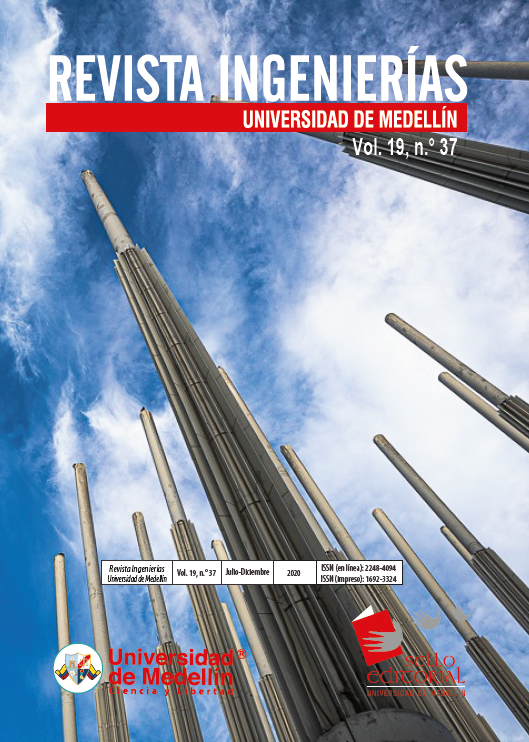Derechos de autor 2023 Revista Ingenierías Universidad de Medellín

Esta obra está bajo licencia internacional Creative Commons Reconocimiento-NoComercial-SinObrasDerivadas 4.0.
- Articles
- Enviado: septiembre 18, 2018
-
Publicado: octubre 4, 2019
Resumen
La iniciativa CDIO —esto es, concebir, diseñar, implementar y operar sistemas y productos del mundo real— es un marco para la educación en ingeniería que considera 12 estándares como referencia para el diseño y evaluación del currículo. Respecto del diseño curricular, una buena implementación de los estándares CDIO puede considerarse un problema complejo multidimensional. Con el objetivo de proponer estrategias para implementar la iniciativa CDIO en el currículo de Ingeniería Electrónica de la Universidad del Quindío, se usó el análisis morfológico general (GMA). Así, algunas dimensiones relevantes del currículo y sus valores se contrastaron en una evaluación de consistencia cruzada (CCA) dentro de la cual se establecieron 8 dimensiones, para un total de 34.560 combinaciones en el espacio de problema. Con lo anterior, el número de combinaciones coherentes se redujo de forma significativa. Finalmente, esas combinaciones se analizaron para proponer las estrategias como insumo para la implementación del currículo CDIO en Ingeniería Electrónica.
Referencias
- [1] K. E. Willcox and L. Huang, “Mapping the CDIO curriculum with network models,” in Proceedings of the 13th International CDIO Conference, 2017.
- [2] A. Álvarez and T. Ritchey, “Applications of General Morphological Analysis From Engineering Design to Policy Analysis,” Acta Morphol. Gen. AMG, vol. 4, no. 1, 2015.
- [3] J. I. Marín et al., “Conceptual Verification of CDIO Skills in the Electronic Engineering Curriculum at Quindío University,” in Proceedings of the 13th International CDIO Conference, 2017.
- [4] Australian Government - Office for Learning & Teaching, “Curriculum Design Workbench (Tool) | Assuring Learning.” [Online]. Available: http://www.assuringlearning.com/curriculum-design-workbench-tool. [Accessed: 17-Sep-2018].
- [5] E. F. Crawley et al., Rethinking Engineering Education, 2014. DOI: https://doi.org/10.1109/FIE.2017.8190506
- [6] H. W. J. Rittel and M. M. Webber, “Dilemmas in a General Theory of Planning,” Policy Sci., no. 4, pp. 155-169, 1973. DOI: https://doi.org/10.1007/BF01405730
- [7] T. Ritchey, Wicked problems–social messes: Decision support modelling with morphological analysis, Berlin: Springer, 2011.
- [8] A. Álvarez and T. Ritchey, “Applications of General Morphological Analysis,” Acta Morphol. Gen., vol. 4, no. 1, pp. 1–40, 2015.
- [9] “CDIO Vision | Worldwide CDIO Initiative.” [Online]. Available: http://cdio.org/cdio-vision. [Accessed: 13-Sep-2018].
- [10] “CDIO Standard 2.1 | Worldwide CDIO Initiative.” [Online]. Available: http://www.cdio.org/content/cdio-tandard-21. [Accessed: 15-Sep-2018].
- [11] “CDIO Syllabus 2.0 | Worldwide CDIO Initiative.” [Online]. Available: http://cdio.org/benefits-cdio/cdio-syllabus/cdio-syllabus-topical-form. [Accessed: 13-Sep-2018].
- [12] National Instruments, “¿Qué es LabVIEW? - National Instruments,” 2018. [Online]. Available: http://www.ni.com/es-co/shop/labview.html. [Accessed: 15-Sep-2018].
- [13] I. Johansen, “Scenario modelling with morphological analysis,” Technol. Forecast. Soc. Change, vol. 126, pp. 116–125, Jan. 2018. DOI: https://doi.org/10.1016/j.techfore.2017.05.016
- [14] J. Biggs and C. Tang, Teaching for Quality Learning at University. 2007. DOI: https://doi.org/10.1097/00005176-200304000-00028
- [15] T. Ritchey, “General morphological analysis as a basic scientific modelling method,” Technol. Forecast. Soc. Change, vol. 126, no. May 2017, pp. 81–91, 2018.DOI: https://doi.org/10.1016/j.techfore.2017.05.027
- [16] T. Ritchey, “Principles of Cross-Consistency Assessment in General Morphological Modelling,” Acta Morphol. Gen., vol. 4, no. 2, pp. 1–20, 2015.


















